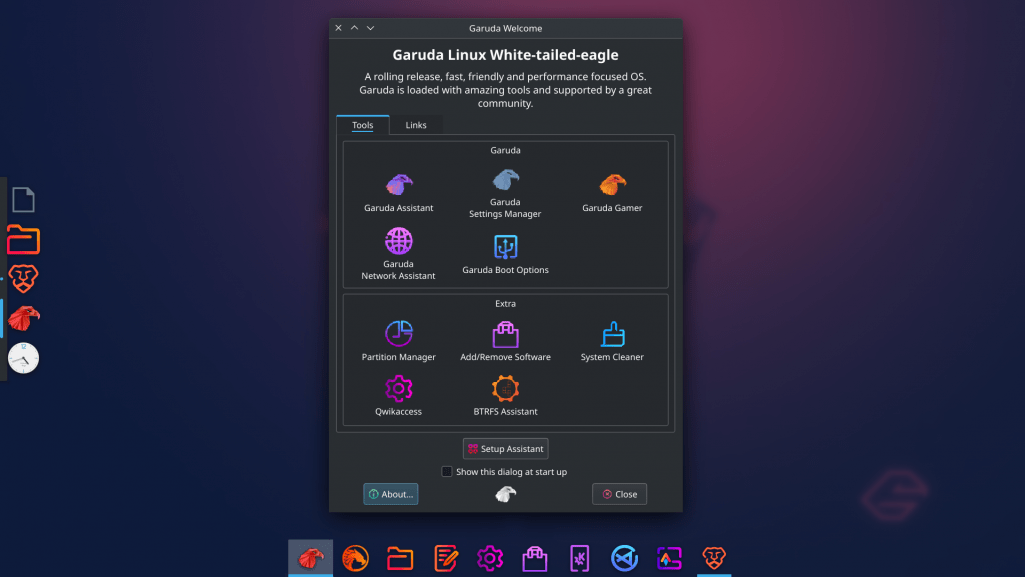Happy New Year. Last year I watched a Garuda Linux review on YouTube and liked what I saw. I have been a long time Linux fan since 2007. The release of Windows Vista enticed me into trying alternatives. At first, I tested out a few. I tried Mandriva, PC Linux, Ubuntu, Linux Mint amongst the most common. At home, I use a Mac but like to fire up Linux often. For the past year, I have been using Ubuntu Budgie which is easy to use without too much configuration. I haven’t used the KDE desktop in a long time so it would be a nice change. Read on to see how the switch to an arch-based distro went.
History of Garuda Linux
Garuda is a relative newcomer to the Linux block. Originating from India and first released in 2020. Garuda offers a rolling release cycle that gives you the bleeding edge software. Within 2 years of its first release, it has already reached the 9th rank on distro watch. Garuda is a bird creature that originates from Hindu mythology. Its features are a mix of an eagle and a human.
Installation
I downloaded the ISO file from the Garuda Linux website. I picked the KDE Dr460nized version which can be demanding on hardware. The minimum requirements are as follows:
- 30 GB storage space
- 4GB RAM
- Video card with OpenGL 3.3 or better
- 64-bit system
The target machine is a 6-year-old Lenovo Yoga Touchscreen laptop.
If you have an interest it has the following specification:
- Processors: 4 × Intel® Core™ i7-6500U CPU @ 2.50GHz
- Memory: 7.7 GiB of RAM
- Graphics Processor: Mesa Intel® HD Graphics 520
If you are struggling to meet the minimum requirements. There are various alternative desktop versions including Gnome, Xfce, Mate and Cinnamon editions. The latter two are community editions. There is also a barebones edition for more advanced users.
I used BalenaEtcher to install the ISO file onto a USB stick. If you run Windows you can also use Rufus which is a lightweight alternative. To get the live distro to work I had to disable secure boot in the bios. The live version loaded well and the installation was pretty straightforward.
The User Interface
Once the installation had finished the distribution loaded within a minute. This particular version uses the KDE5 desktop, which offers a refreshing look. The sweetified plasma dark theme contrasts well with the BeautyLine icon theme. The presentation of this desktop separates it from any other Linux distribution around. The Mac-like features including the top toolbar and dock make it easy to navigate. There are alternative themes available if you navigate to Settings>Appearance>Global Themes. You can also download and install new themes with ease.
The welcome screen points you to a post-installation tool (Setup assistant). This tool is useful to mass install extra software and support services such as file-sharing. You can also install or change the Linux kernel to the latest long term release or a hardened version. The software types featured are also available through the default software manager, Pamac.

Please note: As this is an Arch-based Linux distribution FlatPak and Snap Apps are not supported.
Garuda gamer is a section on the welcome screen. Here you can install games, game launchers like steam and a whole host of emulators. If gaming is your thing you will never suffer from boredom!

The usual shortcuts are available to switch apps etc. I had to create a shortcut to launch Krunner. The mac spotlight alternative is now mapped to Ctrl+Space. This is more of a personal preference.
Developer Software
I have generally used Linux Mint or Ubuntu because they don’t need a lot of setting up for development. Garuda Linux is an arch-based operating system so it’s a whole new experience for me. I use a few different programming languages so need support for Python, Java and Node.
The latest version of Python and Node was available through the software manager. I couldn’t find the new version 17 of Java so had to follow this guide to install it.
The software manager at the time of setup didn’t include the Microsoft version of VS Code. I prefer the Microsoft version so I can sync all the settings and themes. This saves time when developing over many operating systems.
The installation was simple but long-winded. I decided to create a Shell script to install it. Once installed issues were storing the login credentials for GitHub. Every time the app opened I had to log back in to sync my settings or retrieve my GitHub repos. I found the following GitHub thread useful.
Conclusion
Garuda Linux is a refreshing change from other distributions. If you are not familiar with an Arch-based distribution it can be a little of a learning curve. If you are dependent on Snap or FlatPak Apps it is not supported or recommended. On a personal note, I got by without them quite easily. Garuda comes with a decent built-in software manager. You can mass install using the post-installation wizard.
The Garuda assistant offers lots of options to manage and customise your system. The Stacer app is also included to clean cache and tweak startup items. On my machine, it ran without too much difficulty on my 6-year-old Lenovo. If you have a more modern computer with plenty of RAM I don’t foresee any problems running it. As it’s on a rolling release cycle, this can often bring unexpected bugs. I haven’t come across any as yet.
After using the Garuda Linux for 3 weeks I recommend it for both novice and experienced users. The desktop experience is a breath of fresh air, which I would highly recommend.
